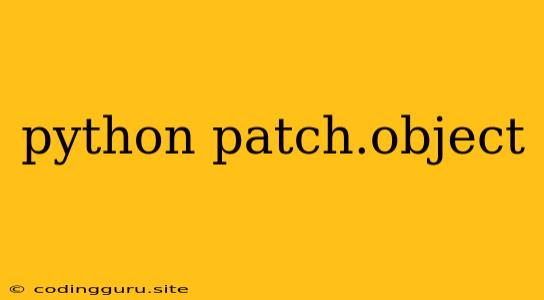Mastering the Art of Mocking with patch.object in Python
When testing Python code, you often encounter dependencies that can make testing difficult or unreliable. This is where mocking comes in. Mocking allows you to replace real objects with simulated ones, giving you complete control over their behavior during your tests.
Python's unittest.mock module provides a powerful tool for mocking, and one of its key features is patch.object. This function allows you to specifically target and replace a particular attribute of an object with a mock object.
Let's delve into the world of patch.object and explore how it can revolutionize your Python testing strategy.
Why Use patch.object?
Imagine you have a function that relies on an external API to fetch data. You need to test this function, but you don't want to rely on the actual API call during your tests. This is where patch.object comes to the rescue.
Here's why patch.object is so valuable:
- Controlled Environment: By replacing real objects with mocks, you create a controlled environment where you can manipulate the behavior of your code without external influences.
- Simplified Testing: Complex dependencies can be replaced with simple mocks, simplifying your tests and making them easier to write and maintain.
- Focus on Logic: Mocking allows you to isolate the logic of your code and test it in isolation, reducing the impact of external factors on your tests.
The Mechanics of patch.object
Let's break down the structure of patch.object:
from unittest.mock import patch
@patch.object(TargetClass, "target_method", new_mock)
def test_my_function(mock_method):
# Test code using mock_method
TargetClass: The class containing the attribute you want to replace.target_method: The specific attribute of the class you want to mock.new_mock: The mock object you want to substitute for the original attribute.mock_method: The name of the mock object within your test function, allowing you to interact with it.
Examples of Using patch.object
1. Mocking a Function Call:
from unittest.mock import patch
class MyAPI:
def get_data(self):
return "Real Data"
def fetch_data():
api = MyAPI()
return api.get_data()
@patch.object(MyAPI, "get_data", return_value="Mocked Data")
def test_fetch_data(mock_get_data):
assert fetch_data() == "Mocked Data"
In this example, we mock the get_data method of the MyAPI class. We replace its actual implementation with a mock that returns "Mocked Data". The test then asserts that fetch_data returns this mocked value, ensuring that our function works correctly regardless of the actual API behavior.
2. Mocking a Method Call:
from unittest.mock import patch
class MyClass:
def do_something(self):
print("Real Action")
@patch.object(MyClass, "do_something")
def test_my_class(mock_do_something):
my_instance = MyClass()
my_instance.do_something()
mock_do_something.assert_called_once()
This example mocks the do_something method of the MyClass class. The test calls the method on an instance of MyClass and then verifies that the mocked method was called exactly once, confirming that the method execution followed the intended path.
3. Mocking an Attribute:
from unittest.mock import patch
class MyObject:
some_value = "Original Value"
@patch.object(MyObject, "some_value", "Mocked Value")
def test_my_object(mock_value):
assert MyObject.some_value == "Mocked Value"
Here, we mock the some_value attribute of the MyObject class. We replace its original value with "Mocked Value". The test then confirms that the mocked value is correctly reflected in the object's attribute.
Advanced Techniques with patch.object
- Side Effects: You can use
side_effectto specify a custom behavior for your mock. For example, you could simulate different responses based on the arguments passed to the mocked function. - Return Values: You can customize the return values of your mock. This is particularly useful for testing scenarios where the real object might return different results under different circumstances.
- Call Assertions:
mock_method.assert_called_once(),mock_method.assert_called_with(arg1, arg2), and other assertion methods allow you to verify that your mock was called with the expected arguments and frequency.
Conclusion
patch.object is an essential tool for crafting robust and effective unit tests in Python. By allowing you to isolate and control dependencies, it enables you to write precise and maintainable tests that focus on the core logic of your code. Whether you need to mock function calls, method calls, or attributes, patch.object provides a flexible and powerful way to achieve your testing goals.
Mastering patch.object is a key step towards writing high-quality, reliable, and comprehensive tests for your Python projects.
